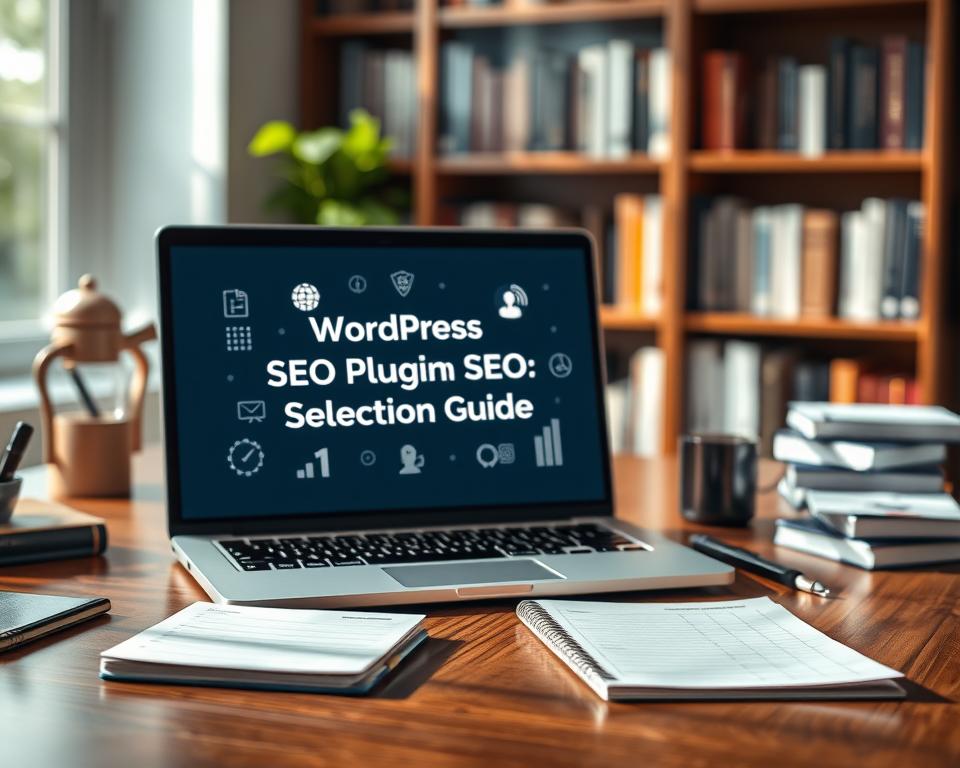Excel at SEO for WordPress: Lightning-Fast Primer
Were you aware that Nearly 4 out of 5 of brands powered by WordPress get enhanced search-engine placements after deploying strategic SEO techniques. WordPress SEO optimization has grown into a essential component for digital success. It transforms websites from hidden to unmissable for search engines.
WordPress offers a powerful foundation for website owners seeking to boost their digital footprint. With native features and scalable optimization tools, WordPress SEO solutions can assist businesses rise on results pages effectively. SEO Marketing Nerds advise harnessing these built-in functions to establish a strong digital presence.
This guide will walk you through the most effective SEO for WordPress, showcasing pro techniques that convert your website into a search engine magnet. Whether you’re a professional SEO consultant or a entrepreneur, these approaches will let you unleash your website’s full potential using optimizing SEO on WordPress.
From learning fundamental optimization techniques to executing advanced strategies, this guide provides practical guidance to improve your WordPress website’s search outcomes. Gear up to plunge into the realm of WordPress SEO and watch your online visibility climb.
Mastering WordPress SEO Fundamentals
WordPress and SEO are in seamless alignment, improving your site’s presence in search results. As a powerful content management system, WordPress lays a steady base for SEO efforts.
Knowing WordPress SEO essentials can transform your site’s digital footprint. It offers distinct advantages for SEO specialists and site owners alike:
- Lean HTML code structure
- Mobile-friendly design capabilities
- Simple content handling
- Extensive plugin ecosystem for SEO tweaks
Opting for WordPress.org instead of WordPress.com gives you complete control for SEO customization. The host-your-own version lets for greater customization, crucial for advanced SEO techniques.
WordPress’s SEO advantages are plentiful:
- Flexible permalink structures
- Rapid content publishing
- Straightforward metadata management
- Native features for search-engine discovery
To improve SEO on a WordPress site, it’s vital to know these basic aspects. Effective WordPress SEO needs a deliberate blend of technical tuning and top-quality content.
Insider tip: A WordPress SEO specialist always prioritizes user experience in addition to search-engine requirements.
Critical WordPress SEO Adjustments
Configuring the right SEO options is vital for any WordPress site. A well-configured WordPress SEO configuration can significantly improve your site’s search-engine performance and visibility. Professional WordPress SEO companies stress a methodical approach to these key settings.

Below are the main settings that make your WordPress site search-friendly:
- Tweak Permalink Settings
- Use simple, keyword-rich URL structures
- Include focused keywords in permalinks
- Avoid lengthy, convoluted URL slugs
- Create XML Sitemap
- Provide a complete sitemap
- Submit to Google Search Console
- Verify all important pages are indexed
- Implement SSL Cert
- Switch to HTTPS for better security
- Enhance WordPress Google SEO ranking signals
- Protect user data
A WordPress SEO premium plugin can make easy these settings. During your WordPress SEO assessment, focus on maintaining a technically sound base that search engines will value. Emphasize logical architecture, quick loading speeds, and clear content hierarchies.
Insider Advice: Regular optimization is essential to sustaining solid search-engine ranking.
Keep in mind, these WordPress SEO-friendly settings are your first step toward better online visibility and search rankings.
Applying SEO in WordPress
To improve your WordPress site’s visibility, a strategic approach is essential. Understanding how to apply SEO to WordPress can significantly improve your web footprint and attract more qualified traffic.
Several strategies can enhance your site’s search-engine positions. These include:
- Optimize title tags and meta descriptions
- Publish valuable content
- Leverage local SEO WordPress techniques
- Build strong internal architecture
- Boost image optimization
WordPress SEO best practices stress several key areas. High-quality content remains the most important factor in search-engine results. Your website should deliver valuable information that satisfies user queries.
For local businesses, targeting geographic-specific keywords is crucial. This means using location-based terms and creating content that speaks with your local audience.
Effective SEO is about crafting a seamless user experience while signaling relevance to search engines.
Back-end optimization is a key component of your WordPress SEO framework. Make sure your website performs swiftly, is mobile-friendly, and has a logical, logical structure. This allows for search engines to crawl your site.
Finding the Perfect WordPress SEO Tool
Selecting the right SEO plugin can dramatically improve your WordPress website’s search results. No matter if you’re a newcomer or an advanced SEO pro, you need robust tools to optimize your site successfully.
When reviewing WordPress SEO plugins, look at these critical factors:
- Intuitive interface for WordPress on-page SEO
- Comprehensive optimization features
- Live content analysis tools
- XML sitemap creation
- Schema markup support
Top WordPress SEO plugins to consider include:
- Yoast SEO: Powerful content optimization tool
- All in One SEO Pack: Comprehensive feature set
- Rank Math: Advanced configuration options
A WordPress SEO agency typically recommends plugins that simplify technical optimization while providing detailed site analysis. Key considerations include usability, performance overhead, and alignment with your specific SEO website WordPress goals.
Expert insight: Always trial plugins in a development environment before production implementation.
Pick a plugin that matches your skill level and provides actionable guidance for improving your site’s search-engine visibility.
On-Page SEO Optimization Techniques
Excelling at on-page SEO is essential for WordPress sites looking for higher search-engine results. Simple SEO WordPress strategies can dramatically lift your content’s performance. This, in turn, attracts more search traffic to your site.
Primary optimization techniques include:
- Writing engaging title tags with focus keywords
- Composing engaging meta descriptions
- Structuring content with strategic header tags
- Building keyword-rich URLs
When utilizing WordPress SEO help, it’s important to craft descriptive title tags. Aim for between 50-60 characters long. Place your primary keyword at the start and include your brand name at the end. These practices help search engines grasp your content’s context.
For top results, concentrate on fine-tuning your content format. Use h1 tags for main titles, h2 for section headings, and H3 for subsections. This hierarchical approach boosts both readability and SEO effectiveness.
URL optimization is another vital aspect of SEO optimization WordPress. Guarantee your URLs are concise, descriptive, and include targeted keywords. Steer clear of complex structures that can confuse users and search engines equally.
Keep in mind: On-page SEO is about creating high-value, comprehensible content that serves both users and search algorithms.
SEO-Focused Content Tactics
Creating powerful content is the cornerstone of WordPress search optimization. An effective WordPress SEO optimization service needs a strategic content approach that draws in both search engines and visitors.
Applying WordPress longtail keyword SEO requires several vital steps:
- Perform thorough keyword research to discover targeted search terms
- Develop content that directly answers user questions
- Offer original, valuable insights not found elsewhere
- Arrange content for readability
When tuning SEO on WordPress, center on creating excellent content that offers true value. Quality outweighs quantity always. Use long-tail keywords naturally within your text, making sure they blend seamlessly with the content.
To enhance SEO WordPress performance, consider these content tactics:
- Write comprehensive articles
- Frequently update current content
- Employ internal linking to link related posts
- Maintain a consistent publishing schedule
Great content is the connection between your website and your readers’ needs.
By applying these WordPress search optimization techniques, you’ll produce captivating content that not only performs well but also delivers tangible value to your visitors.
Technical SEO Implementation
Technical SEO is the backbone of a successful WordPress site optimization plan. The optimal technical elements can significantly boost your website’s search-engine performance and user experience.
When configuring SEO for WordPress, multiple critical technical factors need attention. Site speed is a core ranking factor that directly influences search visibility. Google’s Core Web Vitals now assess websites based on load speed, interactivity, and visual stability.
- Optimize site speed through caching mechanisms
- Minimize HTTP requests
- Compress and scale images
- Leverage browser caching
For WordPress site SEO optimization, think about adding structured data and schema markup. These technical elements help search engines understand your content with greater accuracy. This can possibly enhance rich snippet displays in search results.
Mobile optimization is another critical technical SEO component. With mobile-first indexing, ensuring your WordPress website performs flawlessly across devices is crucial. Responsive design and fast mobile loading speeds are a must-have for ranking well.
Pro Tip: Use advanced SEO WordPress plugins to ease complex optimization tasks.
By utilizing these technical SEO tactics, you’ll create a solid foundation for improved search-engine exposure and user interaction on your WordPress website.
WordPress Image SEO
Visual content is vital for WordPress sites. Optimizing images for SEO can noticeably boost your site’s performance and search results. Well-optimised and tagged images enhance user experience and SEO.
Successful image optimization includes several critical strategies:
- Shrink images to minimize file sizes while retaining quality
- Use meaningful file names containing target terms
- Add meaningful alt text for search-engine understanding
- Implement lazy loading to boost page load times
When optimizing your WordPress site for SEO, keep in mind these image optimization steps:
- Select the right file format (JPEG for photographs, PNG for graphics)
- Resize images before uploading
- Use WordPress SEO plugins like Yoast or EWWW Image Optimizer
“Images are not just visual elements; they’re potent SEO tools when used intentionally.” — Digital Marketing Expert
Embedding WordPress SEO internal links and WordPress SEO links within image captions can further improve your website’s search presence. Keep in mind, well-optimized images lead to faster load times and better user engagement.
Site Architecture & Internal Links
Internal linking is a key element in technical SEO for WordPress, greatly boosting your site’s search-engine ranking. It helps search engines grasp your site’s structure and distributes page authority across pages. This is essential for better search-engine performance.
When optimizing your WordPress site for search engines, remember these critical internal linking tactics:
- Create a logical site hierarchy for simple navigation
- Use descriptive anchor text for context
- Link to related content on your WordPress homepage
- Focus on connecting with your most critical pages
For effective SEO on your WordPress site, add links naturally. This entails inserting links where they deliver real value to readers. Thoughtful internal linking significantly benefits WordPress on-page SEO, assisting search engines in crawling your site’s content structure.
Pro Tip: Think of internal links as a guide that guides both users and search engines through your website’s content landscape.
By using a strategic internal linking method, you’ll enhance user experience, simplify site navigation, and increase your WordPress site’s search-engine visibility.
Improving Speed for SEO
Site speed is a major factor in WordPress SEO performance. Search engines, like Google, prioritize websites that load quickly. This renders speed optimization critical for higher search rankings and a smoother user experience.
To enhance your WordPress site’s speed, begin by assessing its current performance with tools like Google PageSpeed Insights. This tool highlights areas for enhancement in loading times.
- Use caching plugins for WordPress SEO optimization
- Use a Content Delivery Network (CDN)
- Minimize HTTP requests
- Optimize images and media files
Yoast SEO WordPress users can access extra speed optimization features. Lowering server response times and pruning your WordPress database are essential for faster site performance.
Important WordPress SEO tips for speed include:
- Select lean themes
- Delete unnecessary plugins
- Enable browser caching
- Optimize and optimize images
By using these SEO on-page WordPress strategies, you’ll build a speedier, leaner website. This will help it to rank better in search results.
Making WordPress Mobile-Friendly
In today’s online landscape, mobile optimization is key for WordPress sites. Google now crawls mobile versions primarily, affecting your site’s search results. A WordPress SEO course must highlight responsive design for a consistent user experience on all devices.
For responsive WordPress sites, use these SEO optimization WordPress strategies:
- Choose a responsive WordPress theme that adjusts to different screen sizes
- Improve page loading speed for mobile devices
- Ensure legible text without zooming
- Build touch-friendly navigation elements
When tuning for WordPress, test your site’s mobile performance with Google’s Mobile-Friendly Test. WordPress SEO optimizer plugins can quickly spot and fix mobile issues.
Important mobile optimization techniques consist of:
- Compress images for faster mobile loading
- Use responsive design frameworks
- Use AMP (Accelerated Mobile Pages)
- Fine-tune SEO title WordPress for mobile search results
By aiming at mobile optimization, you boost user experience and improve search rankings. Search engines give priority to sites with strong mobile performance, boosting your visibility in search results.
To Summarize
Dominating the top SEO WordPress tactics needs persistence and a commitment to lifelong learning. The techniques we’ve covered offer a strong foundation for boosting your website’s search-engine visibility. From picking the right SEO plugins to implementing technical optimizations, you now have a complete set of tools to boost your site’s performance.
SEO with WordPress is a continuous journey of improvement, not a set-and-forget task. By consistently applying these SEO tactics, you’ll notice your site’s positions increase and draw in more organic traffic. The secret lies in being flexible and continually learning about the latest search-engine algorithms and optimization methods.
SEO Marketing Nerds suggest taking a all-encompassing approach to SEO on WordPress. This means prioritizing content quality, technical performance, user experience, and strategic keyword use. Each element is vital for search engines to interpret and rank your site effectively.
As you proceed to use SEO on WordPress, note that patience and persistence are your most important assets. Monitor your progress, study your data, and be willing to adjust your tactics. With consistent effort and the right methodology, you’ll see notable improvements in your website’s search-engine results.


